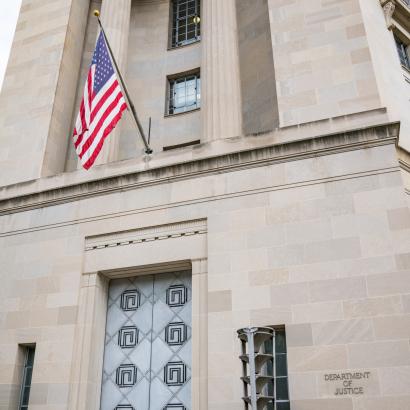- Politics, Institutions, and Public Opinion
The Trump administration’s promises to “drain the swamp” have given rise to initiatives to curtail some of the regulatory activities and procedures of various agencies. The administration’s efforts have achieved some success but there is a long way to go.
Although our government was conceived as three interdependent, coequal branches, it has evolved into an administrative state run mainly by a gargantuan Executive Branch and various independent agencies to which Congress delegates an ever-increasing range of functions. The most prominent of these is the power to promulgate “rules” or “regulations.” Combined with state and local requirements, individuals, public institutions and businesses are subject to a mind-boggling array of overlapping prescriptions and proscriptions.
Federal agencies themselves often contend with difficult-to-achieve statutory deadlines and confusion over what and how to regulate. For regulatory and enforcement agencies such as the FDA, EPA and SEC, enforcement discretion is a tool used for managing their responsibilities in light of budget constraints and various overlapping and sometimes conflicting laws and regulations. Because waivers and enforcement discretion often are not specifically authorized by the underlying statute, they can offer agencies an opportunity to expand their power or to gain leverage over regulated entities that was never intended or even imagined by Congress.
Another mechanism that is analogous to creating or extending programs by waiver or enforcement discretion is the issuance of agency “guidance” documents. Rather than merely explaining the implementation of a legislatively-mandated policy, they can actually create new programs or requirements without clear statutory authority or adherence to requirements such as those of the Administrative Procedure Act (APA). The APA specifies the process federal agencies must use to develop and issue regulations, including requirements for publishing notices of proposed and final rulemaking in the Federal Register, but the requirement for publishing a notice of proposed rulemaking and allowing public comment does not apply to “interpretative rules, general statements of policy, or rules of agency organization, procedure, or practice.”
The Affordable Care Act (ACA) and the Deferred Action for Childhood Arrivals (DACA) offer two illustrations of high-level actions during the Obama Administration. After encountering unanticipated problems in the implementation process of the ACA, officials simply unilaterally delayed implementation of the legislation’s individual and employer mandates. The administration relied on the concept that necessary delay was permissible because of the difficulty complying with the prescribed implementation dates.
On DACA, to provide temporary relief from deportation, the Obama administration created a new program for certain persons, so-called Dreamers, who had entered the U.S. illegally as children. Although they were undocumented, it allowed them to avoid deportation and to remain in the United States for a specified period of time. The administration asserted that it had prosecutorial discretion in the form of "deferred action," an option in individual immigration cases.
Critics of the ACA and DACA policies, as well as other commentators who approved of the intent, challenged the president and agencies for taking these actions without specific legal authority, which, they felt, improperly distorted the underlying laws by the use of administrative discretion. The ACA individual mandate has been repealed by the recently enacted Tax Cuts and Jobs Act, and the repeal of the employer mandate is a goal for the GOP. President Trump tried to terminate DACA using executive discretion, but its demise has been delayed by the federal courts.
For regulatory and enforcement agencies such as the FDA, EPA and SEC, enforcement discretion is a tool used for managing their responsibilities in light of budget constraints and various overlapping and sometimes conflicting laws and regulations. Because the use of waivers and enforcement discretion often are not specifically authorized by the underlying statute, they can offer agencies an opportunity to expand their power or to gain leverage over regulated entities that was never intended by Congress.
Another mechanism that is conceptually similar to creating or extending programs by waiver or enforcement discretion is the issuance of agency “guidance” documents which, rather than merely explaining the implementation of a legislatively-mandated policy, can actually create a new program or requirement without clear statutory authority or adherence to requirements such as those of the Administrative Procedure Act (APA). The APA specifies the process federal agencies must use to develop and issue regulations. It includes requirements for publishing notices of proposed and final rulemaking in the Federal Register, and provides opportunities for the public to comment on notices of proposed rulemaking.
As an indication of how widely used guidance documents are, consider that on February 13, the FDA published “Guidances for Development in 2018,” a list of no fewer than 25 “new topics for guidance documents or revisions to existing guidance documents” that a single FDA entity, the Center for Veterinary Medicine, intends to issue this year. It contains this disclaimer: “[T]he Center is neither bound by this list of topics, nor required to issue every guidance document on this list. We are not precluded from developing guidance documents on topics not on this list.” In other words, independent of the constraints of the APA, the FDA can just make it up as it goes along.
An example is the announcement last December by FDA Commissioner Scott Gottlieb of a proposed draft guidance that would increase the agency’s level of oversight over homeopathic drugs. Although such products are specifically included within the statutory definition of a drug, in 1988 FDA removed these products from the marketing requirements of other drugs by invoking enforcement discretion. Because Gottlieb believes that certain homeopathic drugs now should be held to FDA marketing requirements in light of concerns about their safety, FDA intends to amend its policy to require their premarket review for safety and effectiveness by now excluding certain of these homeopathic drugs from its enforcement discretion.
Another FDA example illustrates how regulators created a new program that relied on both highly dubious statutory authority to issue guidance and on enforcement discretion. In 2009, the FDA promulgated guidance that expanded the definition of a “new animal drug” beyond anything that Congress could have ever contemplated, by specifying that animals modified by certain genetic engineering techniques contain within them new genetic material that falls within the new animal drug definition, and that are therefore regulated by FDA under the Food, Drug and Cosmetic Act. (The Act defines drugs as substances that promote the health of an animal, namely as "articles intended for use in the diagnosis, cure, mitigation, treatment, or prevention of disease" and "articles (other than food) intended to affect the structure or any function of the body of man or other animals.” The FDA includes all such engineered animals regardless whether they would otherwise come under its food or drug regulatory authority.
The FDA guidance thereby created a new regulatory pathway that imposed a burdensome and conceptually inappropriate regulatory regime. The FDA then invoked enforcement discretion to exempt certain genetically engineered—and often less healthy laboratory animals and the commercially available ornamental GloFish®—from compliance with these requirements.
Except for the few exemptions, the Agency’s ill-conceived and burdensome program has virtually wiped out an entire sector of biotechnology – namely, genetically engineered food animals. FDA Commissioner Gottlieb now wants to broaden the FDA’s authority over animal breeding practices by adopting the exiting Obama administration’s proposed expansion of the 2009 policy to include the use of the most innovative, precise, and predictable gene editing techniques such as CRISPR-Cas9.
The FDA relied again on enforcement discretion to create a program that allows the importation into the United States of certain medically necessary drugs in short supply that had been approved only by regulators in foreign countries. In order to allow the importation of these drugs, the FDA asserted that enforcement discretion provides FDA authority to waive the requirement for U.S. marketing approval, but this approach is not without legal risk. In a footnote to the agency’s October 2013 Strategic Plan for Preventing and Mitigating Drug Shortages, the FDA acknowledged its awareness of a relevant recent court decision, Cook v. FDA, in which the court prohibited FDA from using enforcement discretion to permit the importation of an unapproved drug for capital punishment execution because the law is clear that an unapproved drug cannot come through U.S. Customs for marketing. The FDA’s terse comment, “We are currently reviewing the decision in the context of our drug shortages program,” understates the importance of that decision. FDA would face a regulatory crisis were it prevented by a court from using the enforcement discretion rationale.
As a practical matter, although the Cook v. FDA decision would appear to offer a persuasive legal bar to the importation of needed but not approved drugs, it seems unlikely that anyone would challenge the FDA’s use of enforcement discretion to import unapproved medical products approved abroad when they are necessary to save lives, treat disease, or prevent suffering in the United States.
In his essay Government by Waiver, NYU Law Professor and Hoover Institution Fellow Richard Epstein observes that enforcement discretion offers agencies backdoor alternatives to “legitimate policy making,” with unfortunate results for both the regulated market and the rule of law. The power will be used, he believes, to extract concessions from private actors. He notes that administrative agencies that “are given too much discretion can end up blurring the line between coercive power and waiver power in a way that grants these agencies an immense amount of informal authority—authority that extends well beyond the powers they are granted by Congress.”
With such broad discretion in how it enforces standards for new regulated products, the FDA is Epstein’s foremost example of coercive power. Because the Agency’s power is so great, manufacturers will not commonly challenge its approach, regulatory hurdles, or approval conditions because to do so could risk future delays, disapprovals, and difficulties with other products regulated by the Agency.
The misuse of executive discretion is much easier to describe than are practical actions to curb its abuse. Epstein’s worthy solution—sharp constraints on the growth of government and a more skeptical attitude toward the role of government—will be difficult to achieve.
Both Republican and Democratic administrations will resist efforts to reduce enforcement discretion because it can be an important tool for decreasing, as well as increasing regulation. Similarly, while the Trump administration is reviewing agency guidance documents with a view to eliminating those that have improperly instituted new policies, it seems highly unlikely that the administration would prohibit their use if they further the administration's own regulatory agenda.
Because the very nature of enforcement discretion permits it to become abused, reducing the need for enforcement discretion would be a step toward avoiding abuse. The deregulation efforts of the Trump administration could help to remove some of the pressure for its use, for example, by reducing regulatory requirements and the removal of outdated, inconsistent or otherwise unnecessary rules.
The administration took a step in this direction this year when the Department of Justice issued a policy that prohibits the department’s civil litigators from using guidance documents to charge violations of law in civil enforcement actions. Putting it another way, the policy forbids the department litigators from “using its enforcement authority to effectively convert agency guidance documents into binding rules” that have the force of law.
Ultimately, however, Congress bears primary responsibility for the regulatory swamp that requires agencies to use enforcement discretion to function. Accordingly, it is only Congress that has the potential to provide significant relief by more careful crafting of legislation and authorization of appropriations, better oversight and investigations, and the development of innovative legislative control mechanisms like the Congressional Review Act, which provides Congress an after-the fact-process to withdraw recently issued regulations.
Henry I. Miller, a physician and molecular biologist, is the Robert Wesson Fellow in Scientific Philosophy and Public Policy at Stanford University’s Hoover Institution. He was the founding director of the Office of Biotechnology at the Food and Drug Administration. John J. Cohrssen is an attorney who has served in a number of government posts in the executive and legislative branches of the federal government, including as associate director of the President’s Council on Competitiveness and counsel for the House Energy and Commerce Committee.
















